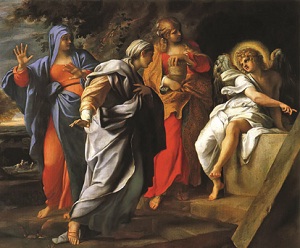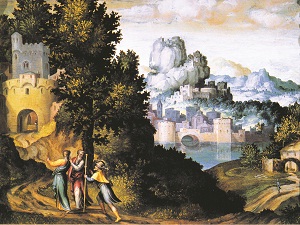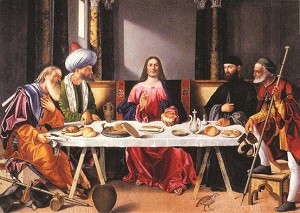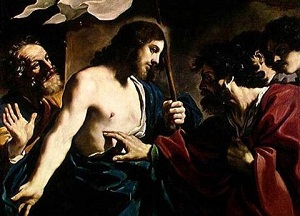The Resurrection is central to our faith and the inspirational force of paintings, writings, literature and traditions throughout the ages. I have taught public school for over forty years and while teaching the History of Art I have found that most high school students have no knowledge of religious events. St. Jerome said, "Ignorance of Scripture is ignorance of Christ."
 |
During the 16th Century there were many magnificent paintings created by Renaissance artists depicting the Resurrection of Jesus and the events that occurred during the forty day period before Christ's Ascension into heaven.
In a painting by Annibale Carracci, "The Three Marys at the Tomb," Mary Magdalene, Mary of Cleophas and Mary of Salome visit the tomb of Jesus. They have come to pray. They brought oil to perform rituals. In the painting an angel sits on top of an empty tomb. You can almost hear the words:
"Do not be afraid, for I know that you seek Jesus who was crucified. He is not here; for He is risen, as He said. Come, see the place where the Lord lay." -Mathew 28:5-6.
The women in a mixture of fear, astonishment and joy, draw back from the Holy Sepulcher.
 |
In the painting "Touch me not," Corregio depicts the meeting of Mary Magdalene and Christ on the morning of the Resurrection. She is crying. Mary sees someone she thinks is a gardener. The Risen Christ bears the marks of the crucifixion. She finally recognizes him. Jesus said to her:
"Do not cling to Me, for I have not yet ascended to My Father; but go to My brethren and say to them, 'I am ascending to My Father and your Father, and to My God and your God.'"" – John 20:17
 |
Continuing this series of paintings of the events after the Resurrection, "The Journey to Emmaus, on the third day of the crucifixion two travelers walk along the road between Jerusalem and Emmaus. In the painting by Paul Brim, the two travelers discuss how the tomb was found empty and how sad they were. They did not recognize Jesus but since the Stranger had unusual knowledge of scripture they invited Him to dinner. "So it was, while they conversed and reasoned, that Jesus Himself drew near and went with them." – Luke 24:15
 |
In "Supper at Emmaus," by Vittore Carpaccio, after their arrival in Emmaus, the pilgrims who are disciples of Christ (but do not yet recognize Him) are seated with Him at dinner. When Christ blesses the bread and wine, the disciples realize His identity.
The final painting is of St. Thomas, "The Incredulity of Saint Thomas." When the Risen Christ appeared to the Apostles as a group, Thomas was not present. The eleven disciples were encouraged by Christ to assure themselves that he was real by touching Him. Told of this, Thomas declared that he would not believe until he could satisfy himself by sight and touch of the Savior. Hence, the expression "doubting Thomas." Eight days later, Christ appeared again. When the Apostle Thomas probed Christ's wounds, he was immediately convinced of His divinity. Italian artist Guercino has imagined this event with Christ holding a banner, symbolizing the Resurrection.
 |
In the paintings and scriptures we have seen and heard the good news of the Resurrection was first spread to the apostles and disciples. It is now our turn to spread the word to our families, children and friends.
One of our wonderful Ukrainian traditions is to continue to spread the good news to our families, friends and parishioners with the words, "Christ is Risen," and answer, "Indeed, He is Risen."
The partaking of our Easter Breakfast at home with our families and at Sviachene (Easter Diner) in our churches with our fellow parishioners is another beautiful tradition.
Another tradition is the preparation of our Easter food basket which is brought to church to be blessed. I can still picture my grandmother and mother teaching me on Good Friday we were not allowed to listen to television or have any noise in the house. We would go to church to visit the grave and say our prayers. Preparation such as embroidering our basket cover or making of pysanky took place months before.
Each item blessed represents the various symbols of Christ and the Resurrection:
HORSERADISH AND BEETS – The red beets signify the blood of Christ, and the horseradish the bitterness of His suffering before His death and Resurrection.
SALT – Just as it is essential to the human body, Ukrainian Christians believe it is essential to the soul
CHEESE, BUTTER, HAM AND KIELBASA – After a long fast, the richness of these foods represent a celebration of God’s creation
EGGS – Symbolic of death and Resurrection, is shared at Easter Breakfast
PASKA – is Easter bread decorated with a cross symbolizing the joy of
new life promised by the Resurrection of Christ
PYSANKY – is simple egg transformed into something extraordinary symbolizing new life
A CANDLE – is always included with the blessing of the Paska because
it symbolizes Christ and the Light of the World
The meaning of the Resurrection is the new beginning that we were given. Jesus died for our sins and we will gain eternal life. I remember the first paska I made when I was first married 48 years ago. I'm afraid I have to feed it to George, a parrot who my husband had in his science office. But I got up the next day and made a new bread. It came out just fine and I blessed it. We must all try again. We all also must pray more including our personal prayers with our families extending to our liturgical prayer in our Church and beyond. This is where we will find strength and inspiration. The Resurrection reminds us to serve our neighbor through acts of mercy as Jesus was merciful to us, we must be merciful to others.
The Resurrection of Jesus is the renewal of life, a second chance for humanity. During these 40 days after the Resurrection of Christ, Jesus wanted to assure his disciples that he was present with them and all the promises he made were true. He left us the Church and Sacraments to guide us. As he selected Peter, he now selected Francis, a humble man to lead us in our journey toward eternity. Christ rose from the dead and we gained eternal life.
